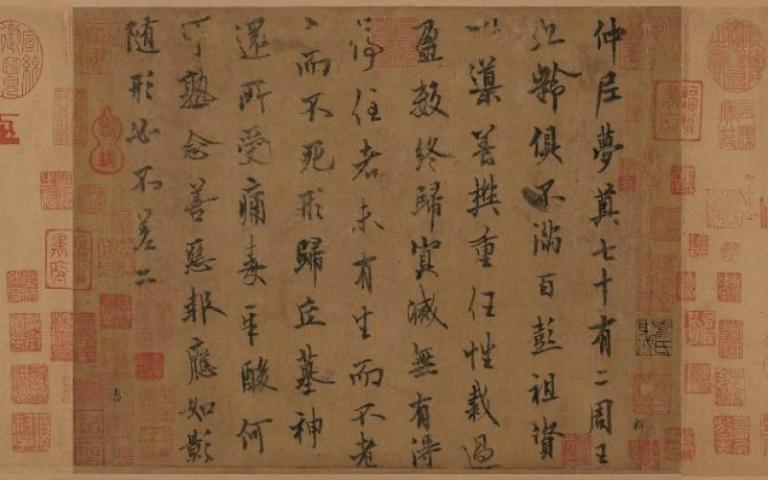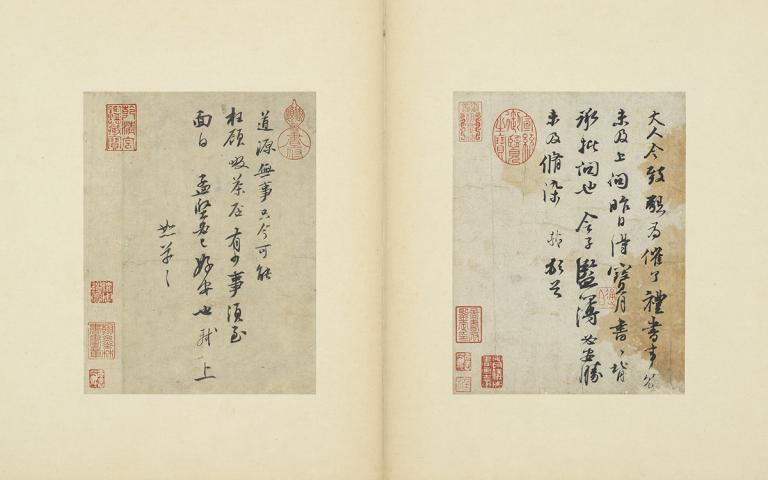Golden Era for Calligraphy in the Qing Dynasty and Various Schools of Stele Scholars
7 min readDuring the reign of Yongzheng and Qianlong in the Qing dynasty, the monarch had gone in for “Wenziyu” (imprisonment due to writings) in a large scale in order to hold back the anti-Qing thought from Han literati. Under such high pressure of culture policy, many intellects were afraid of persecution and avoided talking about politics. They began to devote themselves to epigraphy and boosted the development of textual research on epigraphy.

Along with the appearing of more and more excavation and the popularity of epigraph rubbings, many calligrapher discovered a vast area of calligraphic beauty. They abandoned rubbing books and began to follow stele inscriptions. This was a great turning point in calligraphy history. After Jiaqing and Daoguang period the Qing dynasty gradually declined and was faced with the danger of foreign intrusion and domestic social problems. In the last rears of 90 yea f the Qing dynasty, the culture had witnessed little development.
Yet the great turning in calligraphy history cheered the circle of art and culture. Stele calligraphy suddenly took the place of rubbing calligraphy (calligraphy learned from model copybook) which had lasted for nearly a thousand year, and entered its prime time of popularity. In this period, calligraphers of stele school had expanded their research field hey not only studied seal script and clerical script, but also started to d brushes, which brought new interests and new ways of character-forming into the art of calligraphy. They also encouraged the production of semi-cursive script and cursive script, which had shaken off the manacles of traditional rubbing calligraphy and developed innovatively. In calligraphy theory, Bao Shichen had made great contribution. He made use of the iconoclastic thought to criticize Zhao Mengfu and Dong Qichang’s calligraphy. He greatly advocated the beauty of strength and vigor in calligraphy.
In this period, there were numerous influential calligraphers, the most famous ones included Deng Shiru, who had been honored as “the number one of the Qing dynasty”; Yin Bingshou, who used his brush so skillfully that many seemingly clumsy strokes revealed artful beauty; He Shaoji, who had blended characteristi of seal script into regular script and semi-cursive script; Bao Shichen, whose calligraphy was simple and natural yet artful; Kang Youwei, whose calligraphy was unrestrained and imposing; and Wu Changshuo, who blended the styles from both the south and the north. Deng Shiru (1743-1805), originally called Yan, to avoid being the same with Emperor Jiaqing’s name, used Hang as his courtesy name (zi), Wanbo as his courtesy name (hao), was from Huaining, ng, Anhui. He was a renowned calligrapher and master of seal cutting of the Qing dynasty. Deng Shiru was born in a poor family and was good at seal cutting since he was aoung. Later through his friend, he got acquainted with Mei Miu and other friends in Nanjing and had a view of all epigraph rubbings collected in Mei’s house.

Whenever he found a famous stele inscription or copybook, he would facsimiled for more than a hundred times. He got up early and kept practicing until late at night. His hard working and perseverance laid a sound calligraphic foundation for his seal cutting career. Then he left Mei brothers and traveled all around, living on calligraphy and seal cutting. Deng Shiru was a magnate of the stele school in the Qing dynasty. He was crine accomplished in four sorts of scripts. His seal script was after Li Si and L Yangbing at the beginning, and then following the stone drum inscription and inscriptions from sacrificial vessels and Han steles, so he had absorbed some style rge seal s eaves tiles. Taken in some clerical script style which were close the Qin and Han dynasties.
No wonder he was known as another most disti 1 script calligrapher after Li Yangbing dynasty. His clerical script followed the majestic style of Han stele rascriptions and renewed the style of clerical script in the Qing dynasty. His regular script was learned from stele inscriptions from the Six Dynasties and calligraphy produced by Ouyang Xun and his son, who used the brush decisively to form character structure in compact way. His cursive script absorbed features of the Jin and Tang cursive script, and was written in a hesitant way, yet gave people a smooth and elegant impression.
Among a mong all the four scripts, he was more accomplished in seal script. Meanwhile, Deng was also master of seal cutting. H initiated the Deng School which mainly used small seal script in seal cutting and emphasized intention of strokes The seal cutting works he produced were simple yet imposing, sturdy yet graceful. They were all artful combinations of calligraphy and seal cutt Contemporary people highly appraised his calligraphic achievement and commented that “master of four scripts and number one of the time”. His accomplishment in stele calligraphy really proved the validity of stele study theory and facilitated the development of the stele school, which become the mainstream of that time. He Shaoji (1799-1873), courtesy name (zi) Zizhen, courtesy name (hao) Dongzhou Jushi, was from Daozhou (now Daoxian in Hunan). He was a poet and calligrapher in the Qing dynasty, who had a forthright natural disposition and was very knowledgeable. He was good at poetry and essay writing, classics, history and mathematics, especially epigraphy. He was famous for his calligraphy and was praised as the best in the Qin dynasty. He had also taken in ancient calligraphers’ styles and formed style of his own. After Deng Shiru and Yi Bingshou, he was one of the masters of stele calligraphy with the greatest reputation in the late Qing dynasty. He followed Yan Zhenging in his regular script, and blended in characteristics of stele inscriptions in the N guties and calligraphy of Ouyan Xun, as well as features of stone nasties an inscription in Qin and Han. He also borrowed some elements from seal script and clerical script and finally formed his own style. His small regular script followed got some strokes from clerical script and semi-cursive script.
His semi-cursive script was distinctive with the style of seal script and clerical script as well. His cursive script was honored as “the best in the Qing dynasty”. His perseverance and creative “curved-wrist way of writing” gained him a high reputation. The “curved-wrist way of writing” referred to the way to hold brush with suspending ed wri elbow and curved wrist, which is quite different from natural habit. Though to practice calligraphy in this way was really painstaking and perspiratory he never gave up and eventually accomplished himself as an innovative calligraphy master. Zhao Zhiqian (1829-1884), courtesy name (zi) Yifu, courtesy name (hao) Bei’an, Mei’an, Wumen, etc, was from Kuaiji (now Shaoxing), Zhejiang. He was a painter, a calligrapher and a master of seal cutting. Zhao Zhiqian worked very hard in reading and practicing calligraphy when he was young. He had a good memory and soon became very learned. He was good at painting human figures as well as natural landscape, especially flowers and plants. He followed the way set by Xu Wei, Zhu Da and “Eight Eccentric Painters of Yangzhou” yet used his brush and ink freely and creatively. Being an outstanding painter in the Qing dynasty, he created a new way of freehand brushwork painting of flowers and produced many works with modern characteristics. His calligraphy was learned from Yan Zhenqing at the beginning and later he practiced calligraphy from both the Southern and the Northern schools. Had taken in Bao Shichen’s calligraphic theory, he became follower of stele calligraph and formed his own style which was diversified with fresh artistic conception. He practiced all sorts of scripts and blended style of regular, cursive, clerical and seal script into one and left us large amount of excellent calligraphic works. Meanwhile, he had made lifelong endeavor in poetry, calligraphy, painting and thinking and finally made himself a great art master who had profound influence at the time Wu Changshuo (1844-1927), courtesy name (zi) Junqing, was from Anji, Zhejiang. He was a great master in epigraphy, calligraphy and painting in neoteric China.
Wu was born in very poor family and had studied in a private school in a near village. When he was 20, he started to do farming with his father, but he never gave up learning. He passed the primary imperial examination when he was 22. When he was 56, he served as the governor of Andong county (now Lianshui, in Jiangsu) and quit the position only one month later. Thereafter, he was dedicated to the research of art. He was an omnipotent artist who was good at poetry, calligraphy, painting and seal works as well. In calligraphy, he had learned regular script first from Yan Lugong and later from Zhong Yao; he learned clerical script from stone inscription in the Han dynasty; his seal script was influenced by Deng Shiru, Zhao Zhiqian at the beginning and he finally took in the influence in imitating stone drum inscriptions. For his semicursive- script, Wu Chanshuo learned the use of brush from Huang Tingjian, Wang Duo, and the order and structure from Huang Daozhou. He was also influenced by Northern Wei’s calligraphic style and seal script. His calligraphic work, though small in size on paper, expressed the power able to move a mountain. In the late Qing dynasty, Kang Youwei, Shen Zengzhi, Chen Hongshou, Wu Xizai all left their calligraphic works. Stele inscription study prevailed in the late Qing and served as a satisfactory period in the history of ancient Chinese calligraphy. The major achievement of stele calligraphy was manifested in clerical and seal script. The semi-cursiv script and cursive script had not developed into an equivalent level. It was a pity as well as a revelation that stele calligraphy and rubbing calligraphy were two wings for Chinese calligraphy. Only the combination of the two may guarantee genuine calligraphic miracle.









